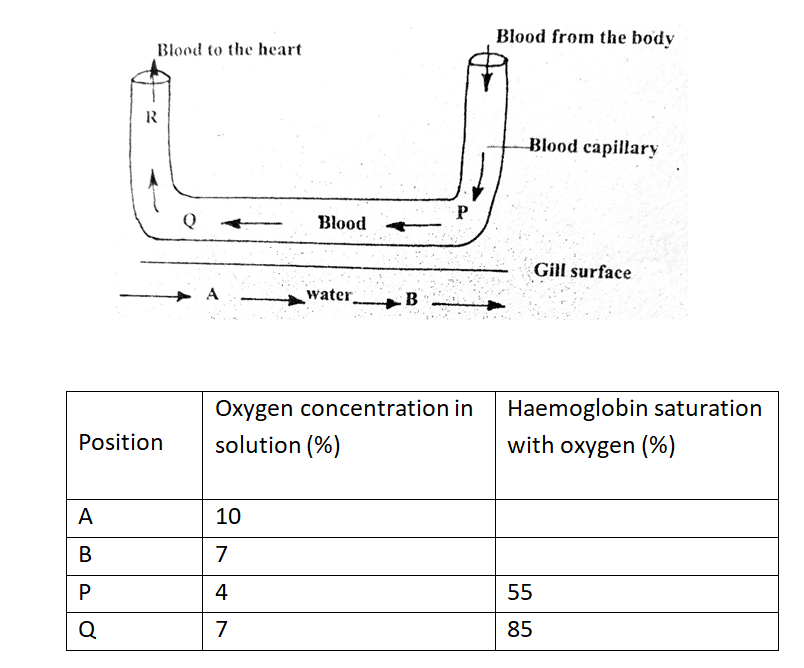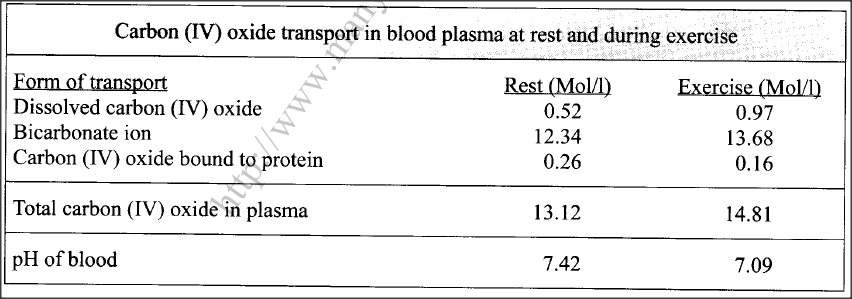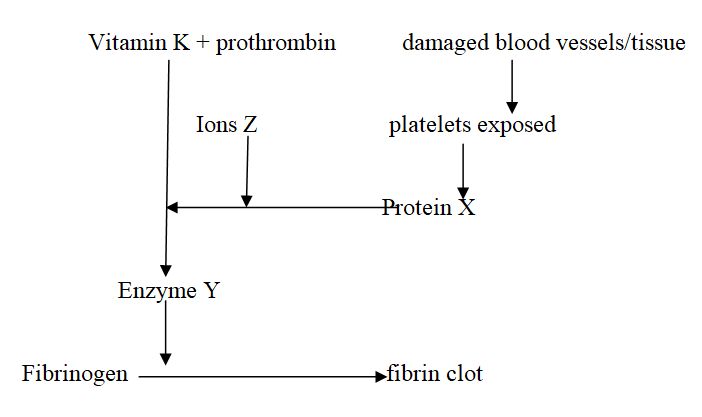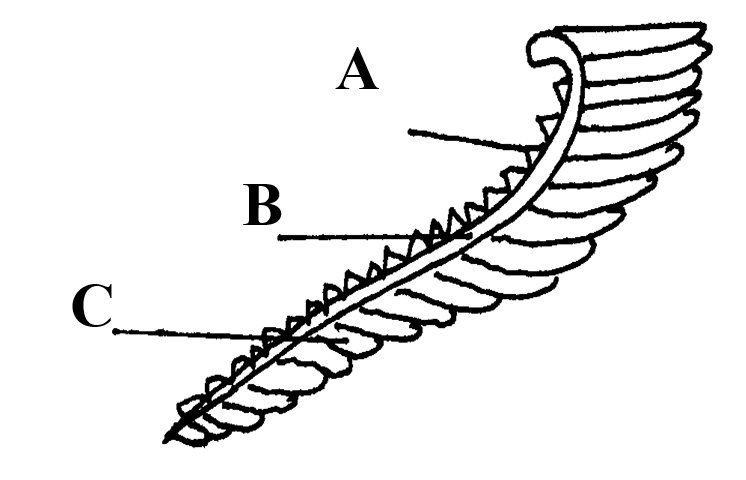The Essential Defense: How Blood Safeguards the BodyThe blood plays a crucial role in protecting the body through various mechanisms. Here are some ways in which the blood protects the body:
0 Comments
The diagram below represents the direction of flow of blood in a gill capillary. The percentage of oxygen in solution at position A, B, P, Q and R is given in the table below.a) Why is the oxygen percentage low at P? (1mk)
Blood coming from the body has supplied the tissue cells with oxygen/ oxygen has diffused out of capillary into the tissue fluid;
b) Using evidence from the data given, suggest what will happen to oxygen in the water at point B. (3mks)
Oxygen concentration at B reduces/will be at lowest; because blood at P has a lower oxygen concertation creating a diffusing gradient; From A to B there is a diffusion gradient hence at B much oxygen has diffused into the from water into the blood;
c) Name the organ into which blood coming from the capillary at Q flows. (1mk)
Heart
d) Suppose the flow of blood in the capillary illustrated above was in the opposite direction, explain the disadvantage it would have to the fish. (2mks)
Amount of exchange of respiratory gasses between blood and water would reduce; because of reduced diffusion gradient;
e) Name the principle where the blood flows in the opposite direction to another fluid. (1mk)
Counter flow system.
K.C.S.E Biology Q & A - MODEL 2017PP2QN02
The table below shows variations in the form carbon (IV) oxide is transported in the blood at rest and during physical exercise.
(a) Explain why more carbon (IV) oxide ¡s transported in the form of bicarbonate ion.
(b)Account for the high total plasma content of carbon (IV) oxide during exercises. (c) State how one’s involvement in the exercises affects blood pH. (d) Name the protein responsible for the transport of carbon (IV) oxide in the blood.
ANSWERS
(a) Presence of carbonic anhydrase enzyme; which speeds up the conversion of carbon (IV) oxide to weak carbonic acid; which dissociates into hydrogen carbonate ion/(HCO3) (that diffuses out of the red blood cells into the blood plasma);
(b)The body needs high amount of energy; (for the exercise/muscle activity) hence high respiration rate (more oxygen intake); releasing more carbon (IV) oxide (in the blood plasma); (c)The high rate of respiration (during physical exercises coupled with normal cellular metabolism) results in the production of more carbon(IV) oxide/faster accumulation of lactic acid; lowering the blood plasma pH/making it more acidic (compared to when one is at rest); (d)Haemoglobin
K.C.S.E Biology Q & A - MODEL 2018PP1QN08
State three ways in which blood capillaries are structurally adapted to their functions.
Name two types of active immunity (2mks)
a) List down two differences between closed and open circulatory systems (2mks)Open system
Closed system
b) Name two ways in which heart muscles are special (2mks)
The scheme below illustrates the blood clotting process;(a) Identify the following; (2mks)(i) Protein X
Thromboplastin / thrombokinase;
(ii) Enzyme Y
Thrombin;
(b) State down the role of ions Z in the scheme above (1mk)
Activates conversion ofinactive prothrombin to active thrombin;
(iii) Name a trait in humans determined by multiple alleles (1mk)
Blood groups;
Set-u A
(a) Why is osmosis regarded as a special case of diffusion (1mk)
Involves the movement of water molecules from a region where they are highly concentrated to a region where they are lowly concentrated through a semi-permeable membrane.
(b) List down two importance of active transport in animals (2mks)
Name two sites where gaseous exchange takes place in an aquatic plant (2mks)
The diagram below represents the gills of a bony fish. Study it and answer the questions that follow(i) Name the parts labeled A,B and C (3mks)
(ii) State the functions of the part labelled A (2mks)
(iii) Explain how the part labelled c is adapted to perform its function (2mks)
(c) Explain why the red blood cells are biconcave and lack a nucleus (1mk)
Explain how the characteristics of the red blood cells adapt it to its functions and the process of blood clotting(a) Explain how the characteristics of the red blood cells adapt it to its functions (4mks)
(b) Explain the process of blood clotting (4mks)When platelets are exposed to air to release thromboplastin; which neutralize anti-clotting factor/heparin and activate prothrombin to thrombin; in presence calcium ions. Thrombin activates conversion of fibrinogen to fibrin which forms meshwork of fibres on the surface injured trapping red blood cells, clot dries up and forms scab stopping for the bleeding
What is the significance of transpiration in plants? (3mks)
(a) What are meristems? (1mk)Regions of plants where active cell division and differentiation takes place. (b)(i) What is the role of cork-cambium in secondary growth? (1mk)Form the bark of the stem (ii) Name the meristem that is responsible for increase in length of stems (1mk)apical meristem K.C.S.E Biology Q & A - MODEL 2019PP2QN08
Explain the effect of increased physical activity on the following organ systems:
(a) heart (b) lungs (c) kidneys (d) skin.
answers
(a) Heart
-Increased heart beat/ rate/cardiac frequency; increase blood pressure; pumping more blood to the muscles/Peripheral blood vessels; at a faster rates; supplying oxygen; Nutrients; for continued oxidation/respiration; to yield energy needed to sustain the (vigorous) contraction/relaxation of muscles during the physical activity; carbon (iv) oxide /Lactic acid/other Nitrogenous wastes/Metabolic wastes produced during the process are also eliminated/ transported to the relevant excretory organs for elimination; the wastes ,if left to accumulate Can also intoxicate/poison cells/cause muscle cramps/pain/fatigue; (b) Lungs -Panting /increased breathing rates; cause the lungs to expand/increase in volume to take in more air/oxygen; and deflate to expel more carbon (iv) oxide; more oxygen is taken in (during exercise) to sustain the process of muscle respiration/to produce the required energy (for constant muscle contraction and relaxation);
Kidneys also maintain the blood plasma pH; and osmotic balance; by elimination excess hydrogen ions(H+) that accumulate to production of Lactic acid/CO2 during the exercise; To maintain the osmotic balance kidneys conserve sodium ions (Na+); and reabsorb water (in the kidney tubules); Leading to reduction in the volume of urine produced; During exercise the kidney tend to filter out urine releasing more in the urine; (d) Skin - Due to increased muscle activity during physical exercise are sweats(more); Eliminating Nitrogenous wastes/ excess water; through the skin/sweat pores) cooling the body; After (water in) sweat evaporates the increased internal body temperature also leads to dilation of superficial blood vessels (vasodilation)/ blood flowing near the skin; leading to loss of excess heat (to the atmosphere) by radiation/ convection; the hair on the skin surface also lie Flat to allow for loss of heat( to the environment) by radiation/convection; K.C.S.E Biology Q & A - MODEL 2019PP2QN02
The table below shows results of blood cell counts per mm3 of blood from a sample of people living at different altitudes.
(a) Explain the relationship between:
(i) red blood cells count and the altitude; (ii) white blood cells count and the altitude. (b) Explain why chances of nose-bleeding increase with altitude in humans.
answers
(a) i) Number of red blood cells increase with altitude; to increase oxygen carrying capacity (by haemoglobin molecules in blood); since oxygen concentration is lower at higher altitude;
ii) white blood cells serve to protect the body against harmful microorganisms/pathogens; thernadites of pathogen of the body to microbial attack is not dependent on the altitude (to be countered by the white blood cell); hence 6 the number of white blood cell count is constant at whatever altitude; (b) Atmospheric Pressure decreases with the increase in altitude; the imbalance between the (outer) atmospheric pressure at high altitude and the internal blood pressure (generated by the heart) results in (one) nose bleeding at high altitudes/ internal blood pressure is higher than the (outer) atmospheric pressure. K.C.S.E Biology Q & A - MODEL 2019PP1QN20
State how each of the following features enhance efficient movement of fish in water:
(a) Scale (b) body shape
answers
(a) faces towards the back/overlap/points backwards to provide a smooth surface for easier movement in water/are stony/ covered with mucus for easier /smooth movement in water/ reduce friction making
(b) streamlined body shape to reduce friction / pointed(stuff) head for easier penetration / passage in water.;
K.C.S.E Biology Q & A - MODEL 2018PP1QN17
Explain the role of carbonic anhydrase in red blood cells.
answers
K.C.S.E Biology Q & A - MODEL 2018PP1QN15
Explain why a bony fish dies shortly after being removed from water.
answers
K.C.S.E Biology Q & A - MODEL 2017PP1QN19
The table below shows the percentage concentration of certain substances in blood plasma, glomerular filtrate and urine in a human being at a particular time.
(a) Explain the likely impact on the composition of urine in case of the following:
(i) Vigorous physical exercises (ii) a meal rich in proteins (b) Name the processes responsible for: (i) Presence of glucose in the glomerular filtrate (ii) absence of glucose in urine
answers
a. i) Less water and urea; since sorne is excreted/eliminated through the skin (as sweat);
ii) increased amount of urea in the urine; due to deamination of amino acids (from proteins); b. i) ultra filtration; ii) Selective reabsorption;
K.C.S.E Biology Q & A - MODEL 2016PP2QN08
Describe how the mammalian heart is structurally adapted to its function.
answers
K.C.S.E Biology Q & A - MODEL 2016PP1QN27
Name the opening to the chamber of the heart of an insect.
answer
K.C.S.E Biology Q & A - MODEL 2016PP1QN27
Name an organism which has a single circulatory system.
answer
K.C.S.E Biology Q & A - MODEL 2016PP1QN27
What is single circulatory system?
answer
K.C.S.E Biology Q & A - MODEL 2016PP1QN04
State three functions of blood other than transport.
answers
K.C.S.E Biology Q & A - MODEL 2016PP1QN04
Name one defect of the circulatory system in humans.
answers
K.C.S.E Biology Q & A - MODEL 2016PP1QN01
State two ways in which the muscles of the mammalian heart are special.
ANSWERS
|
Archives
December 2024
Categories
All
TOPICSFORM 1
Form 2
Form 3
Form 4
|
Can't find what you are looking for? Don't worry, Use the Search Box Below.
|
Primary Resources
College Resources
|
Secondary Resources
|
Contact Us
Manyam Franchise
P.O Box 1189 - 40200 Kisii Tel: 0728 450 424 Tel: 0738 619 279 E-mail - sales@manyamfranchise.com |














 RSS Feed
RSS Feed

